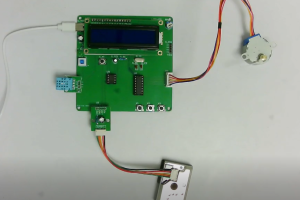设计说明书
总字数:14000+
摘要
在建筑节能与室内环境管理领域,窗户的合理开关控制是调节室内温湿度、改善空气质量及降低能耗的关键环节。若不能根据环境变化及时调控窗户状态,不仅会导致室内舒适度下降,还可能因空调、暖气过度使用造成能源浪费;同时,室外 PM2.5 超标时窗户开启易引发室内空气污染,危害人体健康。因此,研发一种能自动响应环境变化、兼具手动控制功能的节能窗控制系统十分必要。
本设计提出一种基于 STC89C52 单片机的节能窗控制系统。系统主要功能包括:通过 DHT11 温湿度传感器监测环境温湿度,当温度超出预设阈值或湿度高于最大值时,控制步进电机关闭窗户;通过 GP2Y1014AU PM2.5 检测模块监测空气质量,PM2.5 超限时自动关窗,达标时自动开窗;用户可通过 3 个按键设置温湿度及 PM2.5 阈值,并手动控制窗户开关;通过 LCD1602 液晶显示屏实时显示环境监测数据及窗户开关状态。
该节能窗控制系统的作用在于,为建筑节能与室内环境调控提供了一种智能、高效的解决方案。通过自动响应环境变化与手动控制结合,既能保障室内环境舒适健康,又能减少能源消耗,符合绿色环保的发展理念。
关键词:单片机;节能窗;温湿度检测;PM2.5 检测;自动控制
Design of an Energy-Saving Window Control System Based on Single-Chip Microcomputer
Abstract
In the field of building energy conservation and indoor environment management, reasonable switch control of windows is a key link to regulate indoor temperature and humidity, improve air quality and reduce energy consumption. Failure to timely adjust the window state according to environmental changes will not only reduce indoor comfort, but also may cause energy waste due to excessive use of air conditioners and heating; at the same time, opening windows when outdoor PM2.5 exceeds the standard can easily cause indoor air pollution and harm human health. Therefore, it is necessary to develop an energy-saving window control system that can automatically respond to environmental changes and has manual control functions.
This design proposes an energy-saving window control system based on STC89C52 single-chip microcomputer. The main functions of the system include: monitoring environmental temperature and humidity through DHT11 temperature and humidity sensor, controlling the stepper motor to close the window when the temperature exceeds the preset threshold or the humidity is higher than the maximum value; monitoring air quality through GP2Y1014AU PM2.5 detection module, automatically closing the window when PM2.5 exceeds the limit, and automatically opening the window when it meets the standard; users can set temperature, humidity and PM2.5 thresholds through 3 buttons, and manually control the window switch; real-time display of environmental monitoring data and window switch status through LCD1602 liquid crystal display.
The function of this energy-saving window control system is to provide an intelligent and efficient solution for building energy conservation and indoor environment regulation. Through the combination of automatic response to environmental changes and manual control, it can not only ensure a comfortable and healthy indoor environment, but also reduce energy consumption, in line with the development concept of green environmental protection.
Keywords:Single-chip microcomputer; Energy-saving window; Temperature and humidity detection; PM2.5 detection; Automatic control
目 录
1 绪论
1.1 研究背景及意义
1.2 国内外研究现状
1.3 主要内容
2 系统总体方案设计
2.1 系统总体设计
2.2 主要模块方案选择
3 系统硬件设计
3.1 总体硬件框架
3.2 主控模块电路设计
3.3 温湿度传感器模块电路设计
3.4 PM2.5 检测模块电路设计
3.5 ADC 模块电路设计
3.6 显示模块电路设计
3.7 按键模块电路设计
3.8 步进电机驱动模块电路设计
4 系统程序设计
4.1 编程软件介绍
4.2 系统主流程设计
4.3 独立按键
4.4 A/D模数转换子流程
4.5 温湿度检测模块子流程
4.6 LCD1602液晶显示子流程
4.7 步进电机子流程
5 实物制作与功能测试
5.1 实物制作
5.2 温湿度与 PM2.5 检测及显示功能测试
5.3 自动控制窗户开关功能测试
5.4 按键控制与阈值设置功能测试
6 总结
参考文献
致谢
附录A 原理图
附录B PCB
附录C 主程序
购买后可查看具体内容!

